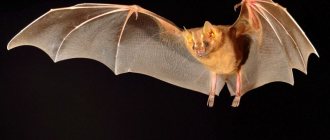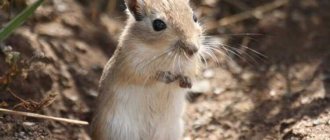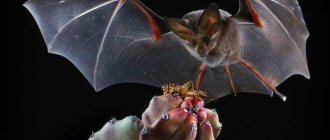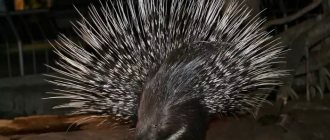A bat is a mammal that belongs to the placental mammals, a species of chiroptera, and is rightfully considered the most mysterious animal. On the one hand, the bat is the only mammal that can move through the air; Based on this ability, they claimed that it was a bird. But, on the other hand, they are viviparous; they feed their young with milk, which birds do not do.
The nocturnal lifestyle of these animals and their frightening appearance have created many legends around them, and some are absolutely convinced that the small animals sleeping in secluded places upside down are real vampires who hunt people and animals to drink their blood. Not everything in these legends is fiction.
Origin of the name bat
The name “bat” itself appeared in Russian only at the beginning of the 17th century, thanks to the translation of a German book. This literary variant caught on, and this is how the animals of the order Chiroptera began to be called.
In Russia, other names were also found: pipistrelle, kozhan, noctule, nocturnal bat, horseshoe bat, long eared bat, arrow-eared bat, tubebill and others. All reflect the external characteristics of these mammals or the features of their way of life.
The same thing is observed in the modern name. Animals that have no family connection with the order of rodents closely resemble them in appearance. And the sound of a bat is similar to the squeak of rodents, and the ability to fly adds a definition that has become the name of the order Chiroptera.
What do bats look like?
It is believed that every fourth mammal on earth belongs to the order Chiroptera. Despite the species differences, they all have common external features.
Wings
The main distinguishing feature of these animals is their wings. It was precisely because of its presence that the debate continued for a long time: a bat is still a bird or an animal.
The wings are thin membranes that are stretched between the fore and hind limbs. Unlike birds, bats do not have feathers, and membranes are attached to the very long fingers of the forelimbs.
The wingspan, depending on the type, can vary from 16 cm to 1.5 m. Despite their apparent fragility, they are able to withstand significant loads and reach flight speeds of up to 20 km/h.
Flight is not the only purpose of wings. During sleep, bats wrap themselves in them, and thus retain their warmth.
Bat Skeleton
The animals' body is relatively small: the spine is much shorter than the modified forelimbs with five fingers with sharp claws. The animal does not have strong limbs, the humerus are shortened, so its movement on the ground is minimal, the main thing for them is flight.
The skull is round in shape with a shortened anterior part in some species and an elongated one in others. If you look at bats, the body is practically invisible. They appear to consist of a head and wings.
Animals have a tail that is not covered with hair. For most, it serves as a device for maneuvers during flight.
Ears
Ears play an important role in the life of an animal that does not have acute vision. In almost all species they are of enormous size.
Numerous networks of blood vessels nourish the ears, since their participation in the life of bats provides them with the ability to move and hunt.
Animals make subtle sounds that bounce off objects and return. This method of orientation in the world is called echolocation. The ability to quickly catch even the quietest sounds helps bats fly at night and hear the movement of potential prey.
Disturbances in the functioning of the hearing organs most often lead to the death of the animal.
Eyes
Chiropterans are nocturnal, which in the process of evolution also affected their vision. In almost all species, small eyes are located in the front part of the muzzle.
The animals of this detachment see everything in black and white. Since the bat sleeps in shelters during the day, its eyes react very poorly to sunlight.
But these animals also have their exceptions. Thus, the California leaf-nosed bat sometimes relies more on sight than hearing when hunting.
If a bat lives as a pet, then you have noticed that it rarely flies into a room in which the light is on, and to catch it, it is enough to turn on the light bulb, and the animal immediately stops flying.
Teeth
Absolutely all chiropterans have teeth: in the jaw you can see incisors, molars and premolars, and fangs. But their number, size and structure depend solely on what bats eat in their natural environment.
Those bats whose diet consists of insects have up to 38 teeth, and the length of their fangs can also vary. Blood-sucking mice typically have a jaw of 20 teeth, and they are not as large or developed as those of their insectivorous counterparts.
The shape of the teeth is adapted to what bats eat in the wild. So, in insectivorous animals, the teeth resemble mortars that grind rough food. But only those who feed on blood have long fangs.
Wool
Most species of bats have a dull color: brown, gray, dark gray. This is due to the need to remain unnoticed during night hunting. But even among these animals there are real fashionistas: the species of Mexican piscivores has bright orange or yellow fur. There are bats in shades that include light tones: fawn, light yellow.
The Honduran white bat boasts a white coat and bright yellow ears and nose.
The quality of the coating may also vary. There are animals with thick and sparse fur, long and short hair.
Echolocation
In the pitch darkness of the caves, there is not enough light for even the most sensitive retina, so their inhabitants do not need acute vision. The animals make their way in the night using an echolocator. This is an amazing result of evolution, which, apparently, appeared relatively recently and continues to be improved. The ancestors of bats had ordinary faces. Modern leafnoses, folded lips and the like have “decorated” their heads with outgrowths that are very reminiscent of the bowls of receiving antennas.
A flying mouse makes frequent clicks at frequencies of 80-130 kHz and uses its huge sensitive ears to catch echoes from surrounding objects. Periodically, the frequency drops to approximately 30-40 kHz, this “squeak” can be heard by people, especially children and musicians. When pursuing prey, the sounds of the locator merge into a continuous squeal, and in a calm flight the animal “ticks” rhythmically. Some mice emit ultrasonic “screams” that have decibel levels comparable to the roar of jet turbines. People, fortunately, do not hear them. The screamers themselves cover their ears with special valves so as not to go deaf.
The bat's brain is large and convoluted. He has a lot of work: in flight, he needs to analyze multiple echoes and create a “3D model” of the surrounding area. Calculate the speed and direction of movement - your own and prey, the distance to obstacles, their size, etc. Vegetarian fruit bats are not very good at echolocation, but they don’t need it: fruits won’t run away anywhere...
Types of bats (insectivores and herbivores)
Studying the life of bats is complicated by their secrecy, but scientists have been able to establish that currently about 700 species of these animals have been recorded. We will tell you about some of them in more detail.
Two-tone leather
The habitat of representatives of this species is almost all countries of Eurasia. You can also find it on the territory of Russia, from Southern Siberia to the western borders. They live in mountains, forests, and steppes. Some animals of this species easily inhabit even the attics of houses in large cities.
The body length of these bats is up to 6.5 cm, and the wingspan is 33 cm. Moreover, they weigh up to 23 grams. These dimensions allow us to say that the two-color leather is a fairly large bat.
The original coloring of the animal determined its name: the ears, muzzle and wings are almost black, the back is dark brown, and the belly is light gray or white.
Two-color leatherbacks feed on nocturnal insects.
Giant noctule
These bats live in the European part. The giant noctule is the largest bat living in Russia. Its body length reaches 11 cm, weight – 70-80 grams, and wingspan – 45-50 cm.
The animal does not have a bright color: they are usually brown or reddish-brown, the belly is noticeably lighter than the back. But it is quite difficult not to notice the flight of these creatures, since their size is impressive.
Observing the life of the noctule bat, it was established that these bats eat large insects. In Russia they prefer beetles and butterflies.
They most often settle in hollow trees. Since low temperatures are possible in their habitats, animals migrate during the cold season, choosing warmer regions.
White leaf-nosed bat
The white bat got its name for its original appearance: their fur is white with slight gray patches on the abdomen. But the nose and ears of representatives of this species are bright yellow, and their shape resembles leaves. It seems that the animal has stuck autumn leaves on itself.
This is one of the small representatives of bats: the body size is no more than 4-5 cm, and the weight is only 7 grams. It is so small that sometimes it seems like it is a bird.
This white miracle lives in South and Central America, Honduras, and Panama. To live, they choose evergreen forests, where they always find food - ficuses and fruits.
The original appearance of the animal attracts attention, so the bat at home is becoming more and more common.
Hog-nosed bat
Representatives of this species are rightfully considered the smallest: their weight does not exceed 2 grams, their body length is 3-5 cm. Sometimes they are confused with bumblebees.
They got their name from their original nose, reminiscent of a pig's snout. The usual color is dark brown, sometimes grayish-brown. The fur on the belly is a lighter shade.
The pig-nosed bat lives in the southwest of Thailand and on some nearby islands. They are not common in other places, so they are rightfully considered endemic to the area.
A special feature of these animals is their cooperative hunting: they usually gather in small flocks and fly out together in search of small insects.
Small bats are difficult to see with the naked eye, making their lives very difficult to observe.
The limited habitat has made the population of these animals extremely small. Currently this species is listed in the Red Book.
Great harelip
These animals live in the territory from southern Mexico to northern Argentina, as well as the Bahamas and Antilles.
The great harelip is a large bat: its weight sometimes reaches 80 grams, its body size is up to 13.5 cm.
The animals have an interesting coloring feature: males are bright red, sometimes even fiery red, but females are very faded, grayish-brown.
These bats received their second name - fish-eating bat - due to their feeding habits. Animals prefer to live near bodies of water. Scientists have found that the harelip eats not only insects, like many chiropterans, but also small fish, small crayfish and frogs.
By the way, they can also fly out to hunt, unlike many representatives of their squad, during the day.
Water bat
The life of representatives of this species was described in detail by the French scientist Daubanton. It was in honor of him that these animals received their second name - Dobanton's bats.
Relatively small animals (weight up to 15 grams, wingspan - no more than 27 cm, and body length - 5.5 cm) prefer to hunt near bodies of water, preferring mosquitoes and other blood-sucking insects as food.
Small-sized bats have a fairly wide habitat: in Russia they can be found in the lower reaches of the Volga, in the Ussuri Territory, on Sakhalin, Kamchatka, in the Primorsky Territory; They also live in other countries: Kazakhstan, Ukraine, Mongolia, Italy.
Unprepossessing in appearance (usually their fur is dark brown), they are excellent hunters, destroying entire hordes of insects.
The decline in the population of water bats contributes to the spread of livestock diseases transmitted through insect bites.
Brown long-eared bat
The most noticeable part of these bats is their huge ears. With a weight of no more than 12 grams and a body size of 5 cm, the ears are sometimes larger than the body. But they cannot boast of their original coloring: their gray-brown fur is very inconspicuous.
Long-eared bats are found in almost all countries of Eurasia, northern Africa, and China.
They adapt almost any place for their homes: caves, buildings, trees. Most often they fly away to warmer regions for the winter, but they always return to their old homes.
Huge ears allow her to hunt even in complete darkness.
Dwarf pipistrelle
It is rightfully considered the smallest representative of the order of bats living in Europe. Its body is up to 4 cm long and weighs 6 g. Representatives of this species have a fairly long tail - up to 3.5 cm.
The color of the animal depends on the region where it lives: in animals living in Asia, it is pale, grayish; in Europeans it is brown.
Bats settle near human habitation, often choosing the attics of houses and barns.
Representatives of this species prefer small insects as food, which helps a lot by exterminating thousands of mosquitoes and midges.
The danger of “neighborhood” with a person
Bats are difficult to classify as pests. They feed on insects and live in hard-to-reach places. Flyers have virtually no contact with humans, but at the same time bring significant benefits. By destroying insects, they protect crops from attack by pests. And by eating midges and mosquitoes, they protect people from unpleasant and painful bites.
But if these valuable “helpers” settle next to the apartment, they can seriously disturb not only the peace, but also cause significant harm.
Human activity has led to a rapid decline in the bat population. Therefore, many species were listed in the Red Book and are protected by law.
Types of bats (blood-sucking)
Observing representatives of the order Chiroptera, we found out that in the wild the bat eats not only insects and plants. Among these animals there are also those that feed on blood.
Common Vampire
A very numerous species has spread the opinion of bats as vampires, capable of drinking all the blood from an animal or a person. Another name is big bloodsucker. The enzyme contained in the saliva of these animals can be quite dangerous: it affects blood clotting. Even a minor wound can cause major blood loss. And if several dozen bloodsuckers attack during the night, then death is inevitable.
This not very large bat (weight no more than 50 grams, and a wingspan of up to 20 cm) spends the entire day sleeping upside down in its shelter in the large company of its fellows, and at nightfall it flies out to hunt. She chooses her prey among sleeping animals, especially prefers cattle - they cannot resist. Choosing a place on the body near the blood vessels, the animal bites and licks the blood, which easily flows out of the wound.
A person can also be attacked by ordinary vampires if he spends the night in places accessible to these bats.
The habitat of this species is South and Central America.
White-winged vampire
A representative of this species has average dimensions for chiropterans: body length is up to 11 cm, weight is up to 40 grams, and the wingspan is up to 40 cm.
Like the common vampire, the white-winged one lives in South and Central America. Its fur has a reddish-brown tint, somewhat lighter on the belly.
The white-winged vampire attacks birds; it is their blood that is the animal’s diet.
Hairy Vampire
It lives in the same places as its brothers that feed on blood. But representatives of this species can easily attack both birds and animals.
Unlike other bats, the bushy-footed vampire does not have well-developed hearing, so in its flights it relies not so much on the usual echolocation as on vision.
Their grayish-brown color and small size allow them to approach their victims unnoticed.
Many researchers have noted that hairy-legged vampires are absolutely not afraid of people: they can fly very close, practically sitting on their hands.
Bats are often frightened by being called blood-sucking and dangerous, but out of all the variety of species, only three actually drink blood.
Brief characteristics of mammals
Bats are representatives of the order Chiroptera mammals. The appearance and size of representatives of this family differ from each other depending on the variety. But absolutely all these animals have a number of characteristic properties, in particular, body structure:
- Bats are unlikely to be confused with any other animal on Earth. Absolutely every mouse has amazing limbs. They are a kind of calling card of these animals. The paws of the animals are united into a common flight system by one membrane. For this reason, the order was called bats.
- The body of mice is covered with thick short hair, and the hind legs really look like mice. The front ones are “sharpened” under the wings.
- The shape of the head varies among different species of bats. Some animals have long ears, while other members of the order have much shorter ears. The same applies to the features of the muzzle. For some, it looks like a pig's snout, while others even look like a dog.
- The size of bats also varies and depends on the specific species of animal. There are very miniature creatures, whose body length is several centimeters, and real giants, up to 0.5 m long. The wingspan of mice can range from 10 to 180 cm.
- The vision of bats is poorly developed, and therefore they see poorly. In addition, these consciousnesses do not distinguish colors at all. Vision problems are compensated by excellent hearing. This is what bats have developed superbly. Some of the varieties are able to detect the sounds made by insects that swarm in tall grass.
Many people are surprised by the truly bat-like habit of sleeping upside down. Meanwhile, this way of relaxation is very practical. This position helps the mice, if necessary, immediately fly about their business. To do this, you just need to wake up and unclench your paws. In this way, animals save time and energy, and in case of danger, these two resources are vital.
In terms of lifestyle, bats are predominantly nocturnal creatures. These mammals are excellent at navigating in the dark and also have the ability to echolocate. This feature distinguishes them from other living beings. Mice are able to evaluate the features of a particular area using the signals they emit and are reflected from surrounding objects. In this way, winged night owls receive a certain picture of reality.
During the day, bats hibernate, living in places where the rays of the sun do not reach. So many individuals have adapted to live in tree hollows, caves, and attics of houses.
Where do bats live?
If we talk about the territories where bats live, then we need to list the entire planet. The only exceptions are areas of tundra and land covered with ice. In these natural conditions, the life of bats is impossible. These animals are not found on some remote islands because they simply could not get there.
The bat is a rare mammal that can exist in almost any place where there is at least some opportunity for shelter during the day.
Representatives of this order can be found in all other corners of the globe. Even in large cities, in the attics of high-rise buildings, bats find shelter.
In nature, bats prefer to settle in caves, where, clinging to ledges, they sleep during the daytime, and at dusk they fly out to hunt. There are caves in which thousands of bat colonies live. Sometimes the height of the layer of excrement in them reaches a meter, which indicates the number of animals and the duration of their stay in this place.
Where there is no natural shelter, these animals are located in trees, hiding between the branches. Sometimes they occupy abandoned hollows, can build themselves shelters from large leaves, gnaw through bamboo trunks, and even settle between the fruits of plants. The main requirements for their house, where the bat sleeps all day, are safety and absence of direct sunlight.
These animals are not at all afraid of people, so they calmly settle in the attics of houses, barns, and livestock buildings.
Sometimes people, not knowing what bats eat in the wild, believe that they can be dangerous to humans and domestic animals. Therefore, when they find these animals in their attic or barn, they try to exterminate them. Most bats eat insects and are therefore absolutely safe.
Habitat
Bats inhabit almost every corner on earth.
The exceptions are Antarctica, the Arctic and some parts of the continents, where the temperature does not rise above zero during the year. Another exception is oceanic and sea islands. But the bats simply could not get there. Scientists believe that if animals are taken to the islands, they will calmly take root and reproduce.
The largest populations are recorded in subtropical and tropical forests. Bats like warm climates and plenty of food. The warmer it is, the more insects, ripe fruits and pollen, and therefore food for growing colonies.
Lifestyle of bats
Bats most often live in colonies, which can number several tens of thousands of individuals. Some species huddle in groups during the day, while others prefer to hang upside down in splendid isolation.
A record number of individuals in one colony was counted in Brazil. In one place there was a refuge for 20 million individuals.
Living together does not make these animals gregarious, since they do not carry out any joint actions: they hunt exclusively alone.
Bats do not create families. Uniting only at the moment of mating, they immediately forget about each other.
In regions where there are cold seasons, animals can hibernate, which lasts up to 8 months. At this time, the bats wrap themselves in their wings, attach themselves upside down in some secluded place and sleep without feeding.
Some species are capable of seasonal migrations. With the onset of cold weather, they fly to warmer regions. Sometimes during this period bats travel distances of up to 1000 kilometers.
If natural conditions allow, animals remain active all year round.
How long do bats live?
An interesting question remains: how many years do bats live in nature? Average life expectancy is 5 years. How long bats live depends on the species. Among these animals there are also long-livers, whose age can reach up to 20 years.
The longest-living record holder among bats is 33 years old.
A bat at home usually lives less than the time allotted to it by nature, since it does not have the opportunity to be fully active.
Folk signs associated with “bloodsuckers”
Bats have always been associated with otherworldly forces, so many signs and superstitions are associated with the animals.
Even if the thought of possible troubles does not leave your head, do not kill the uninvited guest. Carefully help her get out of the house, remembering to protect her hands and body from a possible bite. While you are sending the “visitor” away, read a prayer. Healers assure that such simple actions will completely protect against harm.
How do bats reproduce?
The reproduction of bats has its own characteristics. Some species living in warm climates give birth to young twice a year. The mating period does not matter to them. The secretive way of life of bats does not allow us to accurately imagine how the process of courtship between a male and a female takes place.
Males of some species make a variety of sounds before mating. Perhaps they use this song to attract the female or tell her about their intentions.
Those animals that live in temperate latitudes bear offspring only once. Usually mating occurs in the fall, until the moment when the animals go into hibernation. But the sperm that enter the female’s body do not immediately fertilize the egg, but may remain in some kind of reserve until the moment of awakening.
After hibernation, pregnancy begins, the duration of which depends on both the species and the ambient temperature: at low temperatures, the baby takes longer to develop.
Usually females give birth to one cub, less often two or three. During birth, the mouse turns head up. The baby is born feet first, which is extremely rare in mammals, and immediately goes into the tail pouch, where it spends a week. Afterwards, they hide the babies in shelters and feed them milk. It was this ability of bats that decided the debate: is a bat a mammal or not, in favor of classifying them as mammals.
In the first week, the female takes her cub with her on night hunts. He holds tightly to his mother during the flight. But after a while she is forced to leave him in the shelter, because the baby becomes heavy, and she cannot fly with him for a long time.
A unique sense of smell allows these animals to find their young after flying at night. They can smell the baby's scent from several kilometers away.
For a week, and sometimes two, the kids remain completely helpless, and only after a month they begin to hunt independently near their shelter, without moving far from it.
Reproduction and offspring
The characteristics of the reproduction process of these mammals depend on the species, as well as natural habitats.
For example:
- Smooth-nosed bats give birth to no more than 4 pups each year.
- Long-eared cats reproduce no more than 2 cubs.
- The “flying fox” reproduces offspring in the amount of 1 cub.
Important point! Only the bulldog bat gives birth about three times annually, with only 1 baby being born at a time.
Most species, as well as subspecies, do not have a high reproduction rate, since the female gives birth to only one calf in one year.
What does a bat eat and how does it hunt in the wild?
Almost all bats fly out to hunt at dusk or after sunset. The thing is that their vision is much less developed than their hearing. Most bats feed on flying insects. They hear their movements and pick up prey on the fly or find it among the foliage.
There are animals that feast exclusively on the nectar of flowers and the fruits of fruit trees.
Some large species also eat earthworms and large insects.
Among the chiropterans there is a bat, whose diet includes frogs and small fish, in addition to insects. The animals fly above the surface of the water and determine by the splash where potential prey is located.
But there are only three species of bloodsuckers, and they live in South and Central America. They fly out to hunt at night, find animals, bite and lick the blood.
Interesting Facts
Despite many years of research into the species, many facts about bats still remain a mystery. Yes, and known information can surprise or shock ordinary people.
Interesting Facts:
- Regardless of the location of the shelter, bats always fly to the left side of the entrance.
- Bats have a fast metabolism, so they must eat a lot and often. For example, an average-sized mouse can eat about 600 mosquitoes per night. If translated into human standards, then such a portion will be equal to 20 pizzas.
- During World War II, there were attempts to use folded lips as carriers of explosive shells. A small bomb was attached to the winged “saboteurs” and released over enemy territory. The timer went off when the frightened mouse hid under the roof of the house. The bomb exploded, and the mixture set fire to garbage and other rubbish in the attic.
- Flocks of bats accompany wild and domestic herds that roam the pastures. Small but agile mice eat insects that annoy animals at night.
- Substances contained in vampire saliva prevent blood clotting. Based on these substances, scientists have developed a drug for blood clots to prevent strokes.
- In European mythology and culture, bats are associated with dark forces. And in China, night flyers are positive animals that bring joy and happiness.
- Bats destroy mosquitoes and other blood-sucking insects in large numbers. An important fact is that winged orderlies eat sleeping colonies of mosquitoes that have not yet begun to reproduce. According to research, killing a dozen sleeping insects is more effective than killing 1,000 flying bloodsuckers.
- Only small species prey on mosquitoes; larger insectivores prefer larger food sizes. They eat many dangerous garden and garden pests. They even build special daytime shelters in agricultural fields to lure night hunters.
- All bats, with the exception of vampires, feed on plant foods, fish and insects. They are non-aggressive and never attack people.
- Vampires prefer to avoid humans and hunt exclusively animals.
- Stories about mice attacking or getting tangled in a person's hair are myths based on subconscious fears. Flyers have a perfect echolocation system, so they can accidentally fall or crash into a person only if they themselves are on the verge of death.
- Despite the fact that mice are not inherently dangerous and do not attack people, they pose a real threat. The thing is that they can be carriers of dangerous diseases and are often carriers of the most terrible viruses.
- Species that feed on pollen and fruit pollinate plants along with insects. They also spread seeds and spores.
- Bat droppings (guano) are a source of nitrogen and phosphorus. Mice excrement is used industrially to fertilize crops.
How do bats navigate in the dark?
Bats navigate in space using echolocation (reflected sound waves). The human ear is unable to detect ultrasound, so many people believe that mice can only squeak.
Depending on the species, animals reproduce sound differently.
Some use their mouth, others use their nose. Mice that emit sound waves through their nostrils have curious projections on their noses that help focus the signal.
Ultrasound reaches the object and the mouse “hears” the reflected waves. This signal is so accurate that flyers can identify an object no larger than 0.1 mm in size and even recognize its density. Using echolocation in complete darkness, winged hunters not only “see” their prey, but can also calculate its speed. When approaching prey, mice make sounds at an incredible speed of up to 250 screams per second.
Some insects have learned to “deceive” the echolocation of bats. At the first sign of danger, the insect sits on a branch or falls to the ground like a stone. This disrupts the fine tuning, the reflected waves are “blurred”, showing the overall picture.
Enemies of bats
Bats do not have many enemies in nature, although the animals are very small in size. This is most likely due to the fact that their nocturnal lifestyle does not give them the opportunity to intersect in nature with many animals that are active during the day. They camouflage their shelters well or live in large colonies, which can be quite scary for many animals and birds to penetrate.
Those bats that fly out to hunt at twilight (for example, noctule bats) more often become prey for daytime birds of prey (hawks, hobbies, peregrine falcons), which happily feed on these bats.
But nocturnal birds of prey (owls and owls) quite often attack bats, although hunting them is very difficult: developed echolocation allows you to notice danger and dodge deadly claws and beaks.
Scientists from one of the American institutes noticed an interesting fact: bats living in the caves of one of the mountain ranges of Hungary are attacked by common tits. Brave birds fly into the caves, grab the sleeping animal and take it to their nest. Birds rarely fly up to colonies, since the number of bats can pose a mortal danger to them.
In those latitudes where many tree snakes live, the bats hiding in the branches have a hard time. During the day, animals, as a rule, sleep in shelters and are not always able to react to an approaching creeping enemy. And they practically cannot fly in sunlight, so they become victims of those snakes who can eat small bats.
Chiropterans, especially small individuals and species, often fall into the clutches of spiders. They cannot see a stretched web in the dark; in this case, echolocation does not always help. But chiropterans can hear an insect beating in a web. Sometimes large spiders that feed on small animals do not specifically kill insect prey in order to catch a larger one - a bat.
Sometimes bats become food for larger predators - weasels, polecats and martens, which sneak up on sleeping animals and kill them.
But the most important enemy is man. Sometimes people destroy entire colonies of bats just because they mistakenly consider them dangerous. Although the animals bring a lot of benefits by destroying insects that carry the infection.
It happens that a person does not intend to kill bats. Some fertilizers or pesticides are harmful to flying animals.
It seems incredible that people also eat bats. In many Asian countries, the meat of these animals is considered a delicacy.
Ways to drive away animals
Regardless of whether you are faced with a single uninvited guest or are trying to conquer your own attic from bats, do not forget that these animals can be listed in the Red Book. Therefore, chemical or folk poisons have no place here. You must create such conditions so that the “guests” fly out of the apartment on their own.
Random guest
If you encounter a flying animal in your room, do not panic. The random guest is very confused herself. Finding herself in an unfamiliar environment, she will try to find a way out. And you need to help her a little. Follow three steps to remove a bat from your home.
- Clear the room. Remove children and pets from the room.
- Open the window. Turn on bright lights in the room, pull back the curtains and open the windows wide.
- Leave the room. Close the door behind you, and you can safely return in five to ten minutes. The bat will fly out during this time.
Don't try to drive the bat away by waving a towel. This action can injure the animal. In addition, the movements can seriously anger the guest, and she will attack you.
Fighting a massive invasion
If you are dealing not with one individual, but with an entire colony, then you need to act differently. Only the “tenants” need to be evicted closer to autumn, when the females feed all the young. If you drive out mice in the summer, you will doom the kids to a painful death, and turn your balcony or attic into a real breeding ground for infection. Therefore, put up with rustling and squeaking at night. Get into the fight this fall with these four steps.
- Surveillance. At night, carefully monitor through which cracks and loopholes the bats get out.
- Examination. When the entire flock leaves the home, carefully inspect the room again so that not a single animal remains in it.
- Repair. Now carefully seal all holes, cracks, loopholes using fiberglass, metal gratings, and sealants.
- Cleaning. Complete the procedure with general cleaning of the room using white, Domestos.
Don't forget about the dangers of excrement. Carry out the expulsion procedure in overalls, a respirator, and be sure to wear thick gloves on your hands.
Repellents
If the expulsion procedure does not end in victory, pay attention to numerous methods that can scare away uninvited guests. They allow you to get rid of bats forever, but do not harm endangered animals. Four drugs are most effective.
- Naphthalene. You can drive out mice using mothballs. Place the substance in bags and hang it in different places. The specific smell will completely repel the animals. It is necessary to change naphthalene periodically. It works as long as it continues to smell. Despite its high efficiency, the method can only be used in non-residential premises. Naphthalene vapors are dangerous to humans and pets.
- Water. A simple way to get rid of mice is to take a shower. Point the hose at surfaces that attract “guests” and spray them with cold water. This will get rid of bats, but, unfortunately, not forever. The animals will calmly return to their places as soon as you dry out the garage or shed.
- Aerosol 876 4-Pack Bat Repellent. If you prefer to fight with industrial means, then pay attention to this drug. It contains peppermint oil. When working with the spray, you must take special care so that, along with repelling mice, you do not provoke intoxication in yourself or your pets.
- Ultrasonic repeller. This is another method that allows you to drive away bats without harming them. Such devices emit special signals that humans cannot hear. But this sound is perfectly captured by the “guests”. They cannot put up with such discomfort, so they quickly leave your walls.
There are other, less effective methods. For example, a smoker. But be prepared for the fact that you will have to smoke for at least three to four days. Mice are afraid of light and fans. But you are unlikely to like this procedure. A roaring fan and a bright spotlight are not at all conducive to good sleep. And the amount charged for electricity consumption is unlikely to please anyone.
Source
What benefits do bats bring?
In nature, bats do more good than harm. There are only a few blood-sucking species, so it is impossible to say that it is chiropterans that transmit diseases.
But they destroy insects that, flying from one animal to another, are capable of spreading infections. During the season, animals eat a huge number of mosquitoes, beetles and butterflies, many of which, for example, in tropical countries, actually carry fatal diseases.
They protect chiropteran gardens and agricultural lands from pests that can destroy crops or harm trees and shrubs.
By flying from plant to plant, they help pollinate them.
Bat droppings are an excellent fertilizer. In some caves where animal colonies live, up to a meter of excrement can accumulate.
Enzymes from bat saliva are used in medicine.
Benefits for nature and people
The high rate of metabolic processes in the body of bats forces them to eat large amounts of food. These animals, together with birds, restrain the growth of the number of insects, including pests. Herbivorous bats that feed on nectar provide benefits by pollinating plants. Mice saliva is used for medicinal purposes, and droppings are used as organic fertilizer.
FLYING SQUIRREL
House bat
Recently, people are increasingly keeping not only dogs and cats as pets, but also some exotic animals, including bats. At home, these animals take root, but do not feel as comfortable as in natural conditions. If you still want to keep a bat at home, then try to provide it with a life as close to nature as possible.
First of all, keep in mind that bats are exclusively nocturnal. If you plan to watch it during the day, then you will have to admire the sleeping animal. But at night your pet will want to fly, which can cause a lot of inconvenience.
Pet house
Despite its small size, a bat at home needs a very spacious enclosure where the pet will be able to fly. It is necessary to equip the house with branches and shelters so that the animal has the opportunity to hide during the daytime rest.
The vital functions of bats directly depend on the ambient temperature, so the room where the pet lives should be approximately 30 degrees, which is quite high for a comfortable stay for a person.
A bird cage is not always suitable for keeping bats, since the distance between the twigs is sufficient so that one fine night you can find that the animal is flying above your heads and happily feasting on insects.
What to feed a bat at home?
In the natural environment, most chiropterans prefer insects, which they perfectly obtain for themselves while flying at night. By the way, they should be fed at home in the evening, once a day.
A bat at home does not have the opportunity to feed itself, so the pet’s diet should be as close to natural as possible. But this does not mean at all that owners of unusual pets should catch mosquitoes all evening and bring them to their pet in a jar. What should you feed a small bat if it lives at home?
The following diet is suitable for chiropterans:
- mealworms;
- insect pupae;
- adult beetles;
- raw egg yolk;
- natural honey;
- milk formulas for feeding children up to one month.
Feeding your pet is not so easy: you can add raw yolk, a little honey and vitamin E to the milk mixtures. You need to pick up the animal and offer it the mixture through a pipette. It is not recommended to store the remaining mixture in the refrigerator.
Insects suitable for food are usually stored in jars, but for a short time. A tame bat will happily accept food, but teaching it to eat from your hands is not very easy. It is possible that at first she will refuse food.
Knowing what voracious bats actually eat at home, remember that animals can eat up to half their weight at a time, which can be dangerous to their health with little activity. Don't overfeed them.











